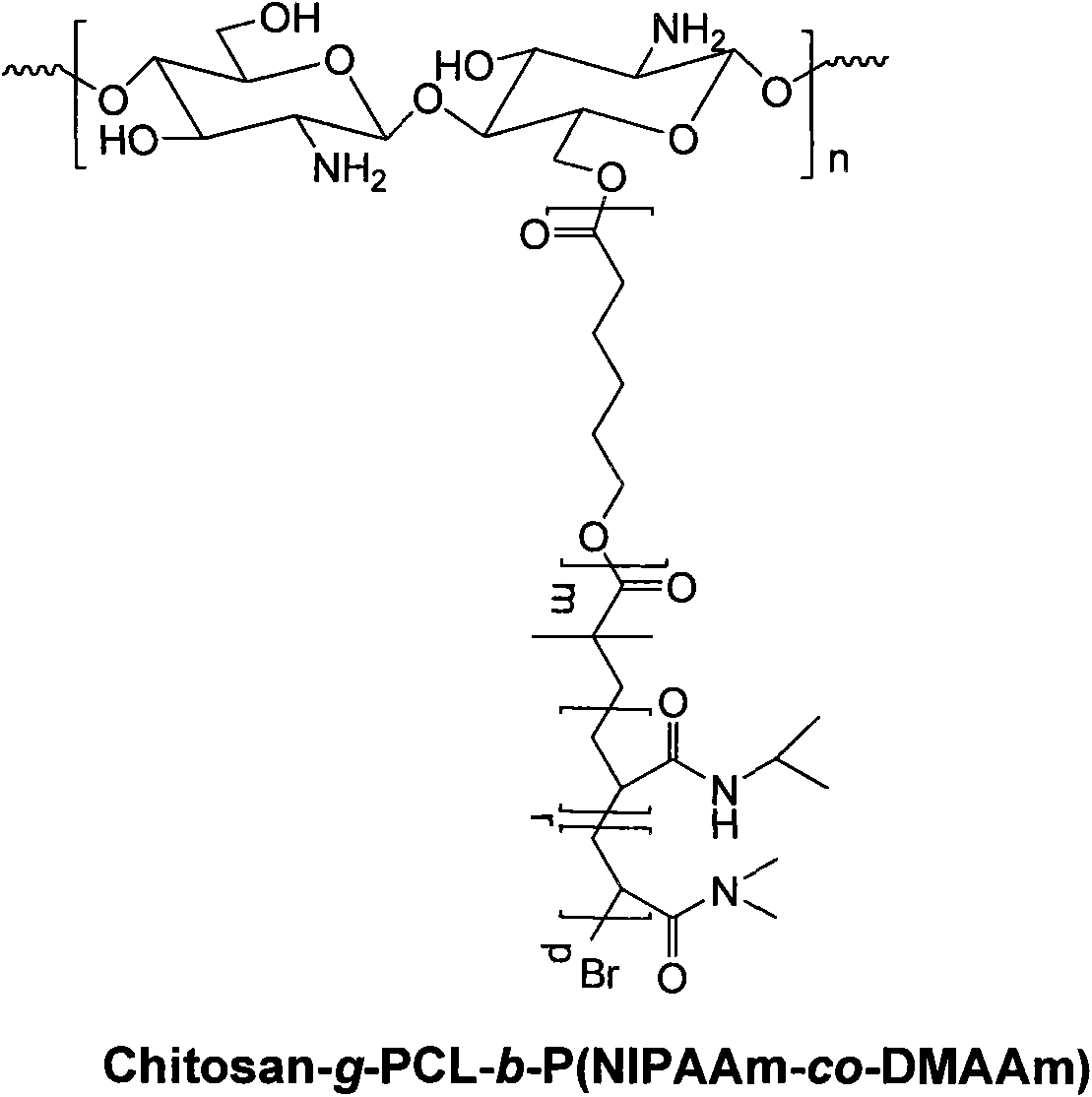Method for preparing temperature-sensitive amphipathic graft copolymer with chitosan as main chain
A technology of graft copolymer and chitosan, which is applied in the fields of polymer materials and biomedical engineering, can solve problems such as single function and unsatisfactory requirements, and achieve the effect of wide sources and simple and easy synthesis method
- Summary
- Abstract
- Description
- Claims
- Application Information
AI Technical Summary
Problems solved by technology
Method used
Image
Examples
Embodiment 1
[0024] Weigh 1 gram of chitosan, disperse and dissolve it with N, N-dimethylformamide, add 10 grams of ε-caprolactone monomer and 88 μmol of stannous octoate as a catalyst, and vacuum-fill with nitrogen for 3 times, and Ring-opening polymerization was carried out in an oil bath at 120° C. for 24 hours under the protection of nitrogen. The product was precipitated with petroleum ether and dried in vacuum to obtain a white solid chitosan-grafted polycaprolactone product. Weigh 5 grams of the chitosan-grafted polycaprolactone product and dissolve it in dichloromethane, add 2 grams of triethylamine, drop 4 grams of 2-bromoisobutyryl bromide at 0°C, and react at 10°C for 72 Hour. After desalting by suction filtration, methanol precipitation and vacuum drying are carried out to obtain bromo-terminated chitosan-grafted polycaprolactone macromolecular initiator. Weigh 2 grams of bromo-terminated chitosan grafted polycaprolactone macromolecular initiator and dissolve in anisole, add ...
Embodiment 2
[0027]Weigh 1 gram of chitosan, disperse and dissolve it with N, N-diethylformamide, add 10.8 grams of L-lactide monomer and 100 μmol of stannous octoate as a catalyst, and vacuum-fill the process 3 times with argon. And ring-opening polymerization was carried out in an oil bath at 150° C. for 10 hours under the protection of argon. The product was precipitated with petroleum ether and dried in vacuum to obtain a white solid chitosan-grafted poly(L-lactide) product. Weigh 5 g of the product and dissolve it in chloroform, add 3 g of diethylamine, add 4.8 g of 2-bromopropionyl bromide dropwise at 5°C, and react at 15°C for 60 hours. After desalting by suction filtration, methanol precipitation and vacuum drying were carried out to obtain bromo-terminated chitosan grafted poly(L-lactide) macromolecular initiator. Weigh 2 grams of bromo-terminated chitosan grafted poly(L-lactide) macroinitiators and dissolve them in anisole, add 5.2 grams of N-isopropylacrylamide monomer and N,N-...
Embodiment 3
[0029] Weigh 1 gram of chitosan, disperse and dissolve it with N, N-diethylformamide, add 11 grams of δ-valerolactone monomer and 20 mg of catalyst aluminum isopropoxide, and go through the process of vacuuming and nitrogen filling for 3 times , and ring-opening polymerization in an oil bath at 110° C. for 30 hours under nitrogen protection. The product was precipitated with petroleum ether and dried in vacuum to obtain a white solid chitosan-grafted poly(δ-valerolactone) product. Weigh 5 g of the product and dissolve it in N,N-dimethylformamide, add 3 g of triethylamine, add 4.8 g of 2-bromoisobutyryl bromide dropwise at 8°C, and react at 20°C for 48 hours. After desalting by suction filtration, methanol precipitation and vacuum drying were carried out to obtain bromo-terminated chitosan grafted poly(δ-valerolactone) macromolecular initiator. Weigh 2 grams of bromo-terminated chitosan grafted poly(δ-valerolactone) macroinitiators and dissolve them in anisole, add 5.6 grams o...
PUM
 Login to View More
Login to View More Abstract
Description
Claims
Application Information
 Login to View More
Login to View More - R&D
- Intellectual Property
- Life Sciences
- Materials
- Tech Scout
- Unparalleled Data Quality
- Higher Quality Content
- 60% Fewer Hallucinations
Browse by: Latest US Patents, China's latest patents, Technical Efficacy Thesaurus, Application Domain, Technology Topic, Popular Technical Reports.
© 2025 PatSnap. All rights reserved.Legal|Privacy policy|Modern Slavery Act Transparency Statement|Sitemap|About US| Contact US: help@patsnap.com

